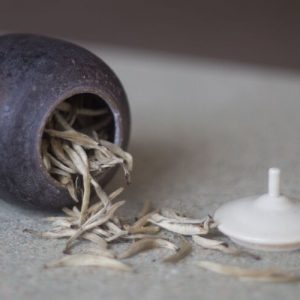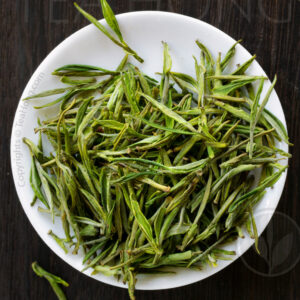Certified organic teas: does it matter?
Even in Hong Kong, we would buy “pond soil” from plant shops to put in our plant pots that we kept in our apartment balcony when we were kids. The most exciting thing about this was not how nice the plant would grow, cause we have had bad experience of using too much pond soil to have killed the plants. It was finding giant snails and earthworms in these pots some months later that I really enjoyed.
Fine tea production: traditional wisdom rules
They don’t use such fertilizers in traditional tea farms though, especially not in fine tea production. They would be too fertile for fine tea growing. This is different in commercial tea production, where the tea field is managed for maximum quantity output, and the sooner there are new leaf shoots, the happier the plantation managers and owners. That is why the soil in such commercial plantations is frequently replenished, using chemical, natural or organic fertilizers. With fertilization comes weeds and other plants, which would be removed with chemicals or so-called eco-friendly natural derivatives. In a vast area where there is only tea tree, there is a severe off-balance in the micro-ecology — weeds and pests thrive.
In traditional fine tea farming, where the quality of tea is a result of slow growth and many harvested only for a couple of times a year, some even only once, there is no need for much soil amelioration. A lot of these farms are actually on sandy slopes. The most common forms of fertilizers in these farms are fermented urine, gypsum, and decomposed peats or other plant parts such as bean pods etc. They are mostly mixed and diluted before adding to the soil once a year or two years. Ants, bugs, worms, peats, weeds, and other plants form a micro-ecology with the dominating tea bushes.
The tea plant, Camellia sinenses, whether of the assamica or sinenses or any other variety, is very tough itself against natural enemies, when it is left alone to grow in the wild. It is when severely transforming extensive of land for monolithic plant type that is the main problem.
In very small farms, chickens wander through free growing tea bushes. You do get worm holes and occasional beetles or fire-bugs in the tealeaves, but at least they are not chopped up and mixed in with the so-called broken, fanning or dusting grades that make your teabags or tiny grains of Orange Pekoe in your tea tin from the supermarket.
So much for traditional farming. Let’s see what organic certification means.
The process of organic certification
To be certified organic, whether a small farm with traditional practices, or a plantation making six, eight, or more times of chopped-up grades a year with automated machines, a certifying agent would have to be hired and annual organic audit have to be conducted. In order to pass the initial recognition and annual audit, there is a set of management and paper works requirement. If it is a new farm starting off from a piece of real virgin land, it is a bit easier with certain land clearing and examination criteria. If the land has been used before, even many years ago, eight years (less in some country or some certifying agents) of managed practices and audit is required before initial certification. Some require that existing plants removed. The whole thing means not only financial costs, but also adequate human resources and loads of bureaucratic conformities. It is a game now for larger firms — many small operators are shut out from the club: tiny traditional farms managed mostly by a single family, some even without internet access, have never been considered as any participants at all. The financial costs aside, just the paperwork alone is highly formidable. In farms where old tea trees are key assets, this is humiliation.
organic tea does not mean quality tea
What really matters to me more, however, is the fact that due to these barriers, most certified organic tea farms are operated by larger firms the owners and managers of which have never had the kind of intimate relationship with tea production as traditional farmers and producers. The vast majority of properly certified organic tea farms produce mass quality rather than traditional quality. To them the pressure for higher output and higher profit margin is more important than tea quality.

Report for EU MRL test for tea
The very long list of test items for MRL test for tea importation into Europe. There are about 290 chemicals to test against in a normal test. This is a report for one of my traditional quality products in my capacity as a tea merchant. Note that the results came out as ND ( non-detectable ) in all items, and yet this is not a certified organic tea. Note also that not all teas sold in EU have been tested.
I am not saying that all organic tea farms are like that, but this is a large part of reality.
As an end-user, I care about food safety as much as taste quality. Most certified organic producers have a long way to go before they are able to produce the kind of tea that I would enjoy drinking. Before there is a solution for labeling traditionally eco-friendly products, I will continue to stick with small farms whose practice is truly traditional and whose owners I know would not be tempted for higher productivity to sacrifice conscientiousness and basic morality. And those who really know about tea.
A better way is yet to be found
Issues in food, health, ecology and environment are a lot more complex than a simple organic label to solve. Many efforts are happening at this moment to counteract corporate controls and domination, even in what seems to be a friendly organic label. The organic label is a domination act and the playground of certain big brothers.
Alternative routes such as cooperatives, trust labels, communities etc are setting up in different parts of the world with one belief — there are better ways for eco-friendly farming. Between squished with pond mud at the toes and heartless mechanical tea manufacturing in plantations, there must be ways that the agricultural communities for sustainable development of fine traditional tea. we just have to find it. The continuum of the highest quality standard in the most important beverage of human heritage will be sustained that way.













Thanks very much for the information, I hope the traditional methods and practices will continue. As much as I like to drink tea (and try to copy what they do in the old style Chinese martial arts movies), I’m willing to pay for very good tea-and you should see the collection of puerh I already have. Thanks.